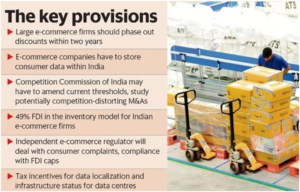e-commerce policy
Context:
A task force of the Commerce Ministry has submitted its recommendations on a draft national e-commerce policy. The suggestions, if accepted by the government, could impact consumers’ online shopping experience in multiple ways, including how discounts are given, the availability of newer products, and the redressal of complaints.
Why does India need an e-commerce policy to begin with?
India’s e-commerce sector, currently estimated to be worth around $25 billion, is expected to grow to $200 billion over the next 10 years.
Much of the growth in the sector is on account of cheaper smartphones and data tariffs, along with enhanced connectivity. Having covered the metros and large cities, the bigger e-commerce firms expect their next phase of growth to come from tier-II and tier-III towns, where the expansion of 3G and 4G networks have put consumers online. This is seen as resulting in job creation, productivity improvement, and increased consumer presence on online platforms.
The task force has said that for India to fully benefit from these opportunities, it is important for policymakers to be cognizant also of the underlying challenges — which makes it imperative to have clearly laid-down rules for electronic commerce in the country.
Many of these rules currently exist in some or the other form, and are enforced by a multiplicity of government departments and regulators.
A national e-commerce policy will be an attempt at creating a one-stop shop for the norms and regulations under which online retailers will be covered.
And what is this task force that has put forward recommendations for the new e-commerce policy?
A 70-member “think tank” was set up in April this year, headed by Minister for Commerce and Industry and comprising the secretaries of ministries including Commerce, Information Technology, Communications, Consumer Affairs, etc., and various industry representatives.
The think tank set up a task force under Commerce Secretary Rita Teaotia to suggest a framework for the national policy on e-commerce. Now that the task force has submitted its recommendations, the think tank will work on creating a draft policy, which will be taken up by the government.
What does the task force say about the inventory model of marketplace operations?
The government does not currently allow foreign direct investment (FDI) in e-commerce companies that hold their own inventories. Online retailers with foreign investments can only operate as marketplaces — letting sellers list their products on the platform. However, given that the lion’s share of investments in e-commerce firms came from abroad, the e-tailers found a way around the government’s norm by setting up seller entities that sold their products on the platforms.
Later, in 2016, the government mandated that no platform should have more than 25% of its sales coming from a single seller. Due to the restrictions on the inventory-based model, e-commerce companies have not been able to offer their in-house brands extensively.
The task force has recommended that FDI may be allowed in inventory-based e-commerce companies up to 49%, with the condition that the e-tailer sells 100% Made-in- India products. This will allow e-commerce firms to offer their own brands — as long as they are made in India.
On the other hand, for online marketplaces, the task force has suggested imposing restrictions on group companies of such platforms to prevent them from directly or indirectly influencing the prices of goods and services. The marketplaces will not be able to offer deep discounts through their in-house companies listed as sellers.
Why is a Central Consumer Protection Authority needed for e-commerce?
There have been several incidents across the country of customers expressing dissatisfaction with products they purchased online. In some cases, bricks and soaps have been delivered instead of mobile phones. This is an inherent flaw of the marketplace model, where platforms do not have full control over the supply chain. Customers have also complained of prices being artificially jacked up higher than the maximum retail price (MRP), and of problems with the delivery of purchased products.
The Consumer Affairs Ministry’s National Consumer Helpline is currently the only redressal mechanism available for such grievances. Between April and November last year, the National Consumer Helpline received 54,114 complaints related to the e-commerce sector. To provide a forum for consumers, the task force has suggested the setting up of a Central Consumer Protection Authority (CCPA), which, besides helping consumers, will also act as the nodal agency for intra-government coordination, and provide a platform for e-commerce operators regarding complaints of fraudulent activities.
Will the ways in which payments are made for online purchases change?
If the task force’s recommendations finally go through and become policy, e-commerce platforms will have to mandatorily provide the government’s RuPay payment option. The task force has also suggested that foreign e-commerce websites should be brought on a level playing field with their Indian counterparts by making them follow the same rules for payment systems such as two-factor authentication.
With the aim to make online payments safer, the task force has also suggested creating a fraud intelligence mechanism, using artificial intelligence-based authentication systems, for early detection of frauds. Currently, a large chunk of payments for online purchases is made through the cash-on-delivery option.







